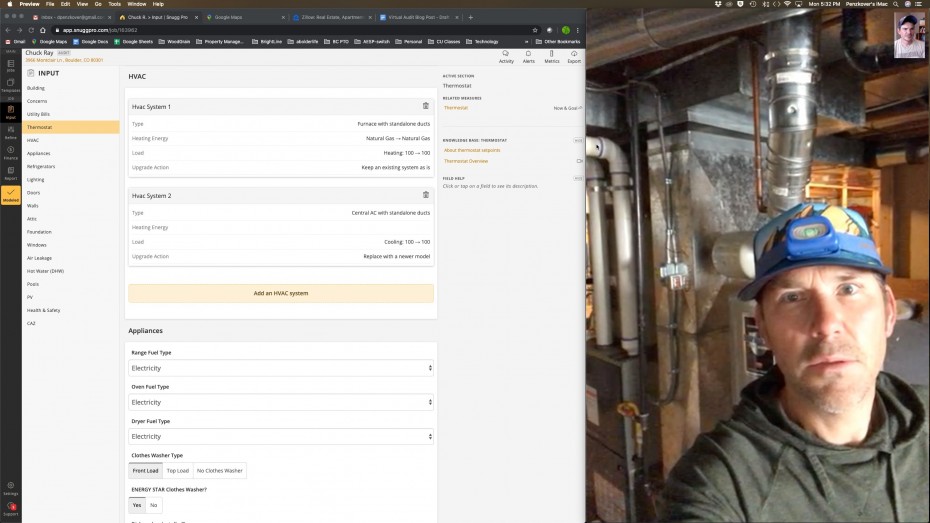The following is a guest post by Chuck Ray, Business Development Consultant and Energy Analyst
People across the US are shying away from inviting energy specialists into their homes. Energy efficiency programs have paused their in-home energy audits, and as the home performance industry looks for new ways to move forward, remote energy audits offer hope.
Distancing is likely to remain a permanent behavior change for the foreseeable future, and that means the home becomes a more tightly controlled sanctuary. Energy costs will be a top priority as occupation time remains high, and indoor air quality may enter the radar of homeowners for the first time.
How can we move forward with increasingly important home energy retrofits?
We do it in the same way that other industries are adapting — leveraging remote communication technologies and elevating direct support. After all, we’re a highly adaptable species and we become comfortable with new norms quite quickly.
There is an interesting opportunity in front of us, one that is immediately actionable. Most Americans sheltering at home have at least some free time on their hand and are often eager to stay productive around the house. These people represent a captive audience ripe for home improvement engagement and now is a great time to review the preplanned job list, reset those meetings, and have conversations on FaceTime, What’sApp, or Google Duo. If remote audits can be run effectively, the job pipeline can be maintained, and when stay at home orders start to lift, retrofits will continue.
Performing a remote audit on my own home
To test the viability of remote audits, and follow-on retrofit decisions by homeowners, I had a home audit performed on my home last week. To my pleasant surprise it went off without a hitch.

Above: Screenshot of the energy auditor's screen during our remote audit with Snugg Pro on the left and me on the right.
This was the energy auditor’s very first remote energy audit, and he too stated that the whole process was far easier than expected. Here is what we did:
Day 1
- A phone call from the auditor to set a time for us to meet over video chat the next day.
- An email follow-up containing the invite to the next day’s virtual meeting, a few questions and a list of things to have on hand for the meeting
- I logged into my utility account, sent over my annual usage, address, and gathered a ladder, headlamp, and tape measure.
Day 2
The next day we launched our meeting over video chat and discussed the sequence of steps. The auditor would be collecting data and photos in Snugg Pro’s energy audit software while he walked me through my house:
- We started the interview with the basics about the house and occupants, and of course he had everything mostly prefilled from the google map view.
- We walked through the interior in less than a half hour, looking at lights, windows, attic, mechanical room, walls, and crawl space.
- Along the way I pointed the phone where requested and he snapped pictures and dropped them right into the audit app.
- The auditor said he’d wrap up and send a report, and we could discuss recommended energy measures and rebates.
- Shortly thereafter I got an email with the Snugg Pro audit report, and we got back on the video chat to discuss.
I was actually surprised how easy and fast the whole process was. I had three conversations with the auditor total of an hour; and the auditor spent perhaps two and half hours end to end.
Programs: Making the shift from field visits to remote audits
Energy New England (ENE), has already revised their processes to make remote energy assessments a core part of their offerings in COVID-19 times. According to an article published by the American Public Power Association (APPA), the homeowner response has been overwhelmingly positive. John Tzimorangas, President and CEO of ENE told the APPA, “I believe we will be doing this activity remote for quite some time into the future and I do see us offering this option when audits are scheduled.”
To facilitate a remote audit transition, utilities and energy programs could alter their acceptance criteria of a complete audit and delay any required blower door test and CAZ testing until the time of retrofit. Several implementers have already made this shift in process, and program managers are in fact starting to consider this method as a more viable long term option that is more cost effective, and increases participation.
Contractors: Making the shift from field visits to remote audits
Contractors will need to adapt their process of engagement and incorporate remote working technologies. Remote audits from the home office will likely be a natural evolution, and appear to be an approach that could streamline the audit-to-decision process, and keeps the job pipeline full.
In any case, continuing with work through this era provides economic buoyancy, demonstrates adaptation, and creates shovel readiness for quick launch in the months ahead. As with all things that force change, we often find greater efficiency in the end. And that is, in fact, what we are all after.
